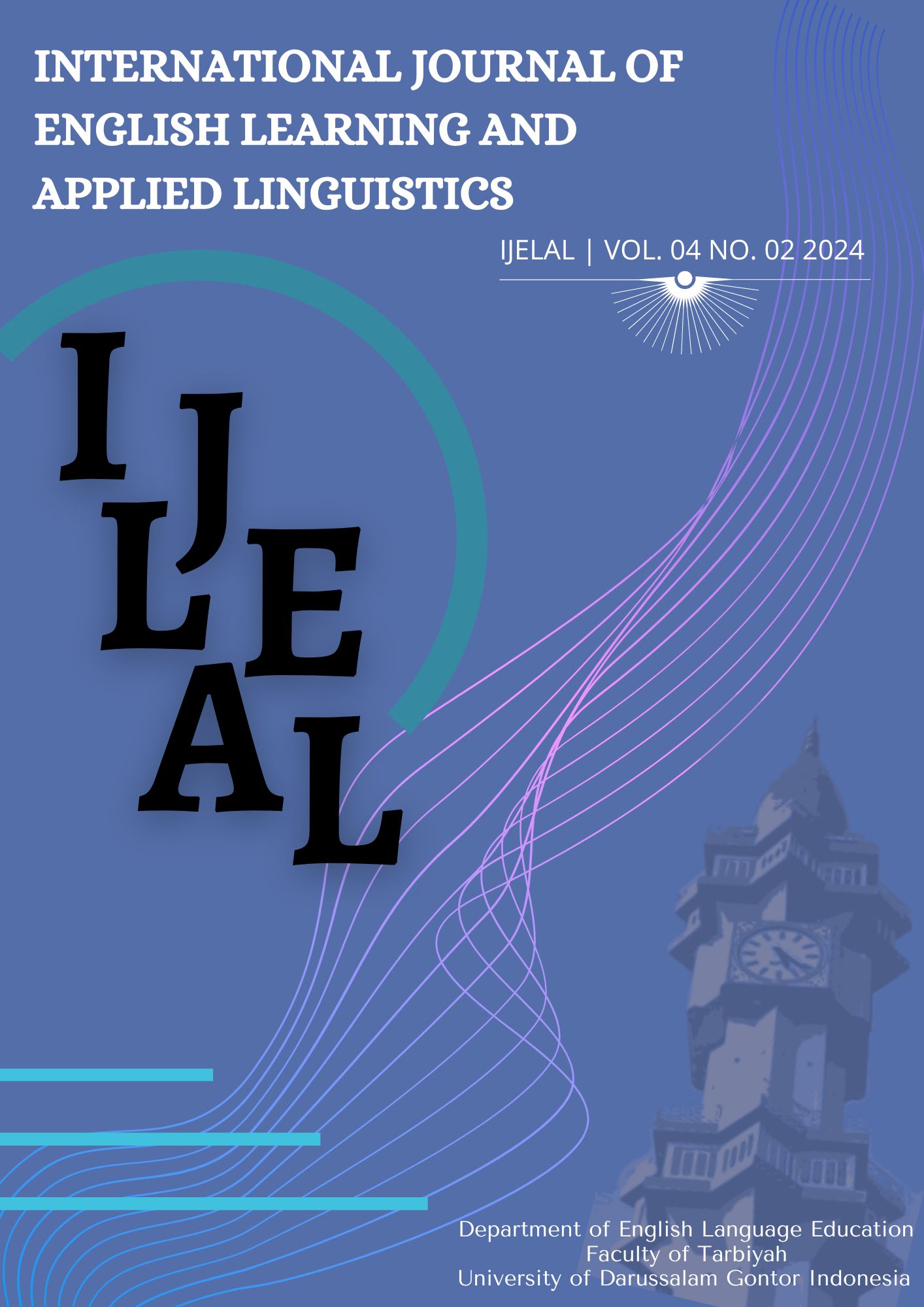THE IMPACT OF THE FLIPPED CLASSROOM METHOD ON LEARNING OUTCOMES
DOI:
https://doi.org/10.21111/ijelal.v4i2.12055Keywords:
EFL, English Grammar, English Vocabulary, Flipped Classroom Method, Reading Comprehension Ability in English, Traditional Teacher-Centered ApproachAbstract
The flipped classroom method, a learner-centered approach, holds potential benefits for EFLinstruction. This study aims to evaluate the effectiveness of the flipped classroom approach inimproving EFL learning outcomes among Iranian undergraduate students. Participants included 120undergraduate EFL learners from an institute in Isfahan. In a mixed-methods approach, studentswere randomly divided into experimental and control groups. The experimental group receivedinstruction through the flipped classroom method, while the control group received traditionalclassroom instruction. Pre- and post-tests were administered to assess the participants' Englishlanguage reading comprehension, grammar, and vocabulary knowledge. In addition, a thematicanalysis was conducted on the students' responses from in-depth interviews to identify and exploreemerging patterns and themes within the data. Paired samples t-test was used to analyze the data.The experimental group demonstrated significantly higher scores on the post-test compared to thecontrol group, indicating that implementing the flipped classroom method in Iranian EFL classroomshas the potential to enhance learning outcomes and motivate students. This study provides evidencefor the effectiveness of the flipped classroom approach in improving EFL learning outcomes amongIranian undergraduate students. Further research could explore the applicability of this approach indiverse cultural contexts and instructional settings. By adopting innovative, learner-centeredmethods like the flipped classroom, educators can transform EFL education and promote studentsuccess.References
Choi, J., & Yi, Y. (2020). Factors affecting the effectiveness of flipped learning: A meta-analysis. British Journal of Educational Technology, 51(5), 1509-1531. https://doi.org/10.1111/bjet.12975
O'Flaherty, J., & Phillips, C. (2015). The use of flipped classrooms in higher education: A scoping review. The Internet and Higher Education, 25, 85-95. https://doi.org/10.1016/j.iheduc.2015.02.002
Lo, C. K., & Hew, K. F. (2017). Flipping the classroom for English language learners in Asia: Benefits and challenges. The Asia-Pacific Education Researcher, 26(3), 181-190. https://doi.org/10.1007/s40299-015-0271-5
Karabulut-Ilgu, A., & Cherif, A. (2021). A systematic review of flipped learning in EFL contexts. Education and Information Technologies, 26(3), 3069-3102. https://doi.org/10.1007/s10639-020-10354-6
Hao, Y., & Lee, J. (2021). The effects of flipped classroom approaches on student learning outcomes in STEM education: A meta-analysis. British Journal of Educational Technology, 52(6), 2094-2109. https://doi.org/10.1111/bjet.13194
Findlay-Thompson, S., & Mombourquette, P. (2014). Evaluation of a flipped classroom in an undergraduate business course. Journal of Education for Business, 89(3), 147-152. https://doi.org/10.1080/08832323.2013.863430
Nguyen, T. M. H., & Bui, T. T. N. (2020). Implementation of flipped classroom in an EFL reading comprehension class. International Journal of Language Education, 4(1), 81-99.
Riazi, A. M., & Mosalanejad, M. (2017). Flipped classroom and willingness to communicate among Iranian EFL learners. Cogent Education, 4(1), 1-13. https://doi.org/10.1080/2331186x.2017.1339389
Bergmann, J., & Sams, A. (2012). Flip your classroom: Reach every student in every class every day. International Society for Technology in Education.
Abeysekera, L., & Dawson, P. (2015). Motivation and cognitive load in the flipped classroom: Definition, rationale and a call for research. Higher Education Research & Development, 34(1), 1-14. https://doi.org/10.1080/07294360.2014.934336
Bao, Y. (2020). The flipped classroom model in Chinese universities: A qualitative study of students’ perceptions and learning outcomes. Journal of Applied Research in Higher Education, 12(5), 755-773. https://doi.org/10.1108/JARHE-09-2019-0202
Bergmann, J., & Sams, A. (2012). Flip your classroom: Reach every student in every class every day. International Society for Technology in Education. (Book - No DOI available)
Bishop, J. L., & Verleger, M. A. (2013). The flipped classroom: A survey of the research. ASEE National Conference Proceedings, 120-127. https://doi.org/10.18260/1-2--21136
Brame, C. J. (2013). Flipping the classroom. Vanderbilt University Center for Teaching. (No DOI available - This is an article from Vanderbilt University's website)
Campbell, D. T., & Stanley, J. C. (1966). Experimental and quasi-experimental designs for research. Rand McNally.
Chen, Y. C., Wang, W. C., & Lin, Y. C. (2021). An exploration of a flipped classroom approach on the motivation, learning strategies, and learning outcomes of ESP students. Computer Assisted Language Learning, 34(1), 1-25. https://doi.org/10.1080/09588221.2021.1908289
Chen, Y. C. (2016). Student learning outcomes in a flipped English classroom. Indonesian Journal of English Language Teaching and Applied Linguistics, 2(1), 35-42. https://doi.org/10.15408/ijeltal.v2i1.2372
Etikan, I., Musa, S. A., & Alkassim, R. S. (2016). Comparison of convenience sampling and purposive sampling. American Journal of Theoretical and Applied Statistics, 5(1), 1-4. https://doi.org/10.11648/j.ajtas.20160501.11
Enfield, J. (2013). Looking at the impact of the flipped classroom model of instruction on undergraduate multimedia students at CSUN. TechTrends, 57(6), 14-27. https://doi.org/10.1007/s11528-013-0722-5
Hung, H. T. (2015). Flipped classroom: A new trend in higher education. Journal of Education and Training Studies, 3(6), 92-99. https://doi.org/10.11114/jets.v3i6.801
Köroğlu, B., & Çakır, R. (2021). Effects of flipped learning on student engagement, achievement, and critical thinking: A systematic review and meta-analysis. Turkish Online Journal of Educational Technology, 20(5), 201-216. https://doi.org/10.17051/tohte.2021.5.36
Lage, M. J., Platt, G. J., & Treglia, M. (2000). Inverting the classroom: A gateway to creating an inclusive learning environment. The Journal of Economic Education, 31(1), 30-43. https://doi.org/10.1080/00220480009596294
Mayer, R. E. (2009). Multimedia learning: A cognitive theory of multimedia learning. In T. C. Reeves & S. Yamashita (Eds.), Proceedings of World Conference on E-Learning in Corporate, Government, Healthcare, and Higher Education 2009 (pp. 13-18). Association for the Advancement of Computing in Education (AACE). https://doi.org/10.1007/978-3-319-56153-4_2
Mazur, E. (1997). Peer instruction: A user’s manual. Prentice Hall. (Book - No DOI available)
Namaziandost, E., & Jalilifar, A. (2021). Flipped classroom model: An effective approach to enhance Iranian EFL learners’ writing skill. Cogent Education, 8(1), 1962707. https://doi.org/10.1080/2331186x.2021.1962707
O’Flaherty, J., & Phillips, C. (2015). The use of flipped classrooms in higher education: A scoping review. The Internet and Higher Education, 25, 85-95. https://doi.org/10.1016/j.iheduc.2015.02.002
Oxford University Press & Oxford University Press Hellas. (2001). Oxford quick placement test. Országos Pedagógiai Könyvtár és Múzeum.
Shadish, W. R., Cook, T. D., & Campbell, D. T. (2002). Experimental and quasi-experimental designs for generalized causal inference. Houghton Mifflin Company.
Strayer, J. (2012). How learning in an inverted classroom influences cooperation, innovation and task orientation. Learning Environments Research, 15(2), 171-193. https://doi.org/10.1007/s10984-012-9108-7
Taherdoost, H. (2016). Sampling methods in research methodology; how to choose a sampling technique for research. SSRN Electronic Journal. https://doi.org/10.2139/ssrn.3205035
Wang, F., Zhang, H., & Chen, Z. (2015). A critical review of the flipped classroom approach. Journal of Educational and Social Research, 5(2), 59-64. https://doi.org/10.5901/jesr.2015.v5n2p59
Zainuddin, Z., & Halili, S. H. (2016). Flipped classroom research: A systematic review and meta-analysis. International Journal of Engineering & Technology, 7(4), 19-26. https://doi.org/10.14419/ijet.v7i4.11145
Downloads
Submitted
Accepted
Published
Issue
Section
License

This work is licensed under a Creative Commons Attribution-NonCommercial-ShareAlike 4.0 International License.
Copyright notice:
- Authors retain copyright and grant the journal right of first publication with the work simultaneously licensed under a Creative Commons Attribution License that allows others to share the work with an acknowledgement of the work's authorship and initial publication in this journal.
- Authors are able to enter into separate, additional contractual arrangements for the non-exclusive distribution of the journal's published version of the work (e.g., post it to an institutional repository or publish it in a book), with an acknowledgement of its initial publication in this journal.
- Authors are permitted and encouraged to post their work online (e.g., in institutional repositories or on their website) prior to and during the submission process, as it can lead to productive exchanges, as well as earlier and greater citation of published work (See The Effect of Open Access)





